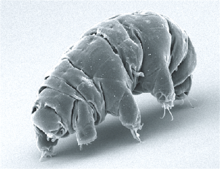
Back Waterbeertjie Afrikaans Bärtierchen ALS የውሃ ድብ Amharic بطيء الخطو Arabic لءبي ARZ টাৰডিগ্ৰেড Assamese Ərincəklilər Azerbaijani سۇ آییلاری AZB Аҡрын йөрөүсөләр Bashkir Tardigrada BCL
| Tardigrades Temporal range:
| |
|---|---|

| |
| Milnesium tardigradum, a eutardigrade | |

| |
| Echiniscus succineus, a heterotardigrade | |
| Scientific classification | |
| Domain: | Eukaryota |
| Kingdom: | Animalia |
| Subkingdom: | Eumetazoa |
| Clade: | ParaHoxozoa |
| Clade: | Bilateria |
| Clade: | Nephrozoa |
| (unranked): | Protostomia |
| Superphylum: | Ecdysozoa |
| (unranked): | Panarthropoda |
| Phylum: | Tardigrada Spallanzani, 1777 |
| Classes | |
| |
Tardigrades ('water bears') are microscopic, segmented animals.[1] They live in water. They are members of the tactopod phylum Tardigrada, part of the superphylum Ecdysozoa. They are also known as water bears or moss piglets.[2][3]
Tardigrades were first described in 1773.[4] Their name means "slow stepper". There are more than 1000 different species of tardigrade.[5]
Tardigrades have a cylindrical shape with four segments, each with two legs. Each leg has little claws.[5] The biggest adults may reach a body length of 1.2 mm, the smallest below 0.1 mm. Freshly hatched larvae may be smaller than 0.05 mm.[4] Tardigrades feed on plant cells by penetrating the cell wall and eating what is inside. Some tardigrades are carnivores.[6][5]
Tardigrades are eutelic: all adult tardigrades of the same species have the same number of cells. Some species have as many as 40,000 cells in each adult, while others have far fewer.[7][8]
Tardigrades can be found in many habitats: in moss,[6] freshwater,[6] the Himalayas,[4] and the ocean.[4] They are one of the few animals that can be found on the highest mountains and the deepest seas.[4] About 83% of the known species live on land, the other 17% live in water.[5]
- ↑ Neuman, Yair (October 2006). "Cryptobiosis: A new theoretical perspective". Progress in Biophysics and Molecular Biology. 92 (2). Elsevier: 258–267. doi:10.1016/j.pbiomolbio.2005.11.001. PMID 16380155.
- ↑ Miller, William (2017-02-06). "Tardigrades". American Scientist. Archived from the original on 2018-04-14. Retrieved 2018-04-13.
- ↑ Simon, Matt (21 March 2014). "Absurd Creature of the Week: the incredible Ccritter that's tough enough to survive in the vacuum of space". Wired. Archived from the original on 2014-03-25. Retrieved 2014-03-21.
- ↑ 4.0 4.1 4.2 4.3 4.4 Riffenburgh, Beau (2007). Encyclopedia of the Antarctic. Vol. 1 (illustrated ed.). CRC Press. p. 983. ISBN 978-0-415-97024-2.
- ↑ 5.0 5.1 5.2 5.3 Margulis, Lynn; Schwartz, Karlene V. (1998). Five kingdoms: an illustrated guide to the phyla of life on earth (illustrated ed.). Elsevier. p. 324. ISBN 978-0-7167-3027-9.
- ↑ 6.0 6.1 6.2 "Tardigrade (animal)". Encyclopædia Britannica. Archived from the original on 2011-01-23. Retrieved 2011-01-02.
- ↑ Seki, Kunihiro; Toyoshima, Masato 1998. Preserving tardigrades under pressure. Nature 395 (6705): 853–854. Preserving tardigrades under pressure | Nature Archived 2021-02-14 at the Wayback Machine
- ↑ Kinchin, Ian M. 1994. The biology of tardigrades. Ashgate Publishing.
© MMXXIII Rich X Search. We shall prevail. All rights reserved. Rich X Search